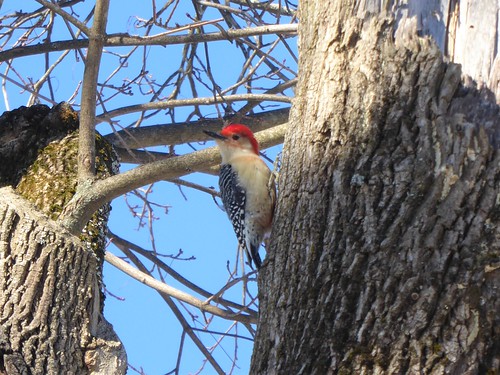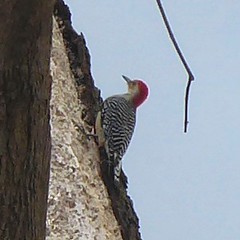I’ve been seeing one or more male red-bellied woodpeckers nearly every time I walk the dog these days: either several birds are staking territorial claims on several different side streets, or one bird has been faithfully following me.
Red-bellied woodpeckers are large and vocal: it’s hard not to see them once you recognize their call and take the time to look for them. And right now, the male red-bellies in our neighborhood are perching on dead snags, excavating holes, and calling: almost begging to be seen. Although I can identify red-bellied woodpeckers by eye and ear, I’m realizing how little I know about their lives. Why am I only seeing male red-bellies right now, for example? Are the females just as plentiful as the males, but quieter? And are red-bellied woodpeckers conspicuously abundant every March, and this is the first year I’ve actually noticed them?
According to the Cornell Lab of Ornithology’s account of red-bellied woodpecker behavior, “When nesting, males choose the site and begin to excavate, then try to attract a female by calling and tapping softly on the wood around or in the cavity.” So apparently the calling males I’ve seen around our neighborhood are trying to attract mates to the nest holes they’ve begun to excavate. Now that I know the general areas where several male red-bellies are looking to nest, it’s likely I’ll see them in the same spots for years to come, as “The same pair may nest in the same tree year after year, but typically excavate a new cavity each year, often placing the new one beneath the previous year’s.”
Apparently, red-bellied woodpeckers have been calling, tapping, and nesting in our neighborhood for years, and I’m only now paying attention. What other creatures have led their not-so-secret lives while I’ve been hurrying around, unaware?



Mar 20, 2019 at 2:19 am
What is it about the color red that throws us into a confusion of mis-labeling? Purple onions are called “red onions.” Purple cabbage is called “red cabbage.” In Korea, black tea is called “red tea” (hong-cha). And those obviously red-headed woodpeckers are called “red-bellied woodpeckers.” Mighty Cthulhu!
As for there being a world of secret lives: I suspect that there are large, conspiratorial communities of animals out there, regarding our civilization with envious eyes and slowly, surely drawing their plans against us.
LikeLiked by 1 person
Mar 20, 2019 at 9:06 am
There is a woodpecker with a completely red head, and they were named before red-bellies.
https://www.allaboutbirds.org/guide/Red-headed_Woodpecker/id
Both birds were named in the days when ornithologist used guns, not binoculars, to study birds, and if you hold a red-bellied woodpecker in your hand, they have a tinge of red on their bellies, by their legs. But you can’t see if while they’re clinging to trees.
LikeLike
Mar 20, 2019 at 9:06 am
And yes, one of these days an intrepid dogwalker will discover Bigfoot. 🙂
LikeLike